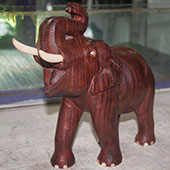Design Resource
Wooden Elephant - Thrissur, Kerala
An Abstract Wooden Art
by
Prof. Bibhudutta Baral, Divyadarshan C. S. and Amulya S.
The wood is brought from local forests around. Woods like white cedar, rain tree, rose wood and many local trees are cut with Jigsaw, chiseled and carved in making this traditional elephant. The wood is cut into blocks according to the measurements of elephant. The templates made out of corrugated paper is placed on the block and marked with the help of the chalk, pencil or sometimes directly marked by chiseling around the template. The marked block is then further processed for carving. Firstly the artisan is taking the chisels, mallet, and tools and placing it nearby for an easy movement of the process. Chisels are of different sizes and bits, which is used in different intervals of carving process. The big flat chisel is used in initial stage of carving to remove the unwanted extra chunks of wood. Then shaping of the subject is taken over by the detailing chisels like small flat bit chisel, Slant cutting chisel, small thin bull point chisel, straight chisel, ‘V’ tool, Straight gouge, Fishtail pattern gouge, Fishtail pattern chisel, Curved gouge and many more. After which the eyes, nails and tusks places are dug with the help of ‘V’ tool and replaced with the white cedar wood, which makes the occurrence of the elephant more effective. Pad saw with blade is used in making wrinkle lines and skin folds on the elephant. Emery paper and sand paper is used in smoothening and finishing of the wood surface. After smoothening the elephant is given a timber coat wood finishes which, is used in filling the minute gaps in the wood. Later a coat of shoe polish based is applied based on the color required like for brown lusterless elephant brown shoe polish is applied. Melamine polish is used on the sculpture to protect the surface and preserve the lusterless appearance. For a black shiny elephant a wood stain paint is used and given a coat of wood varnish which give a lustrous look.
Flow Chart:























